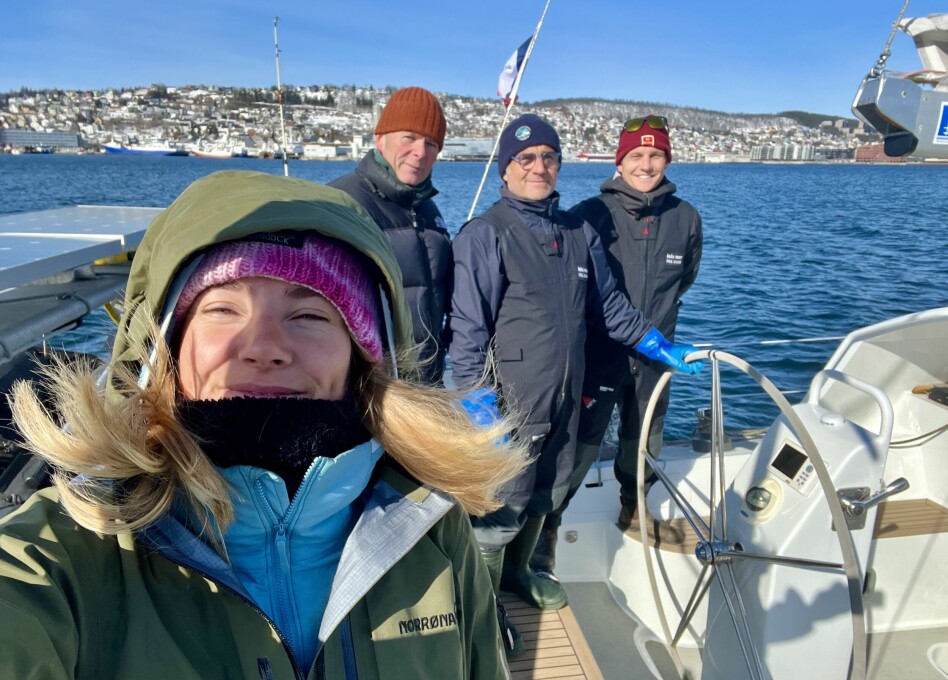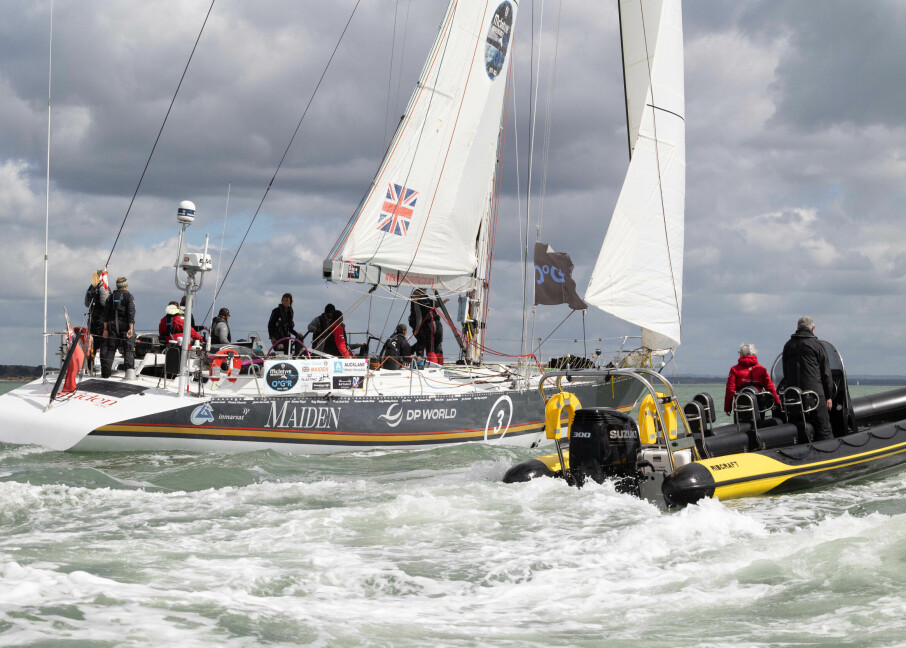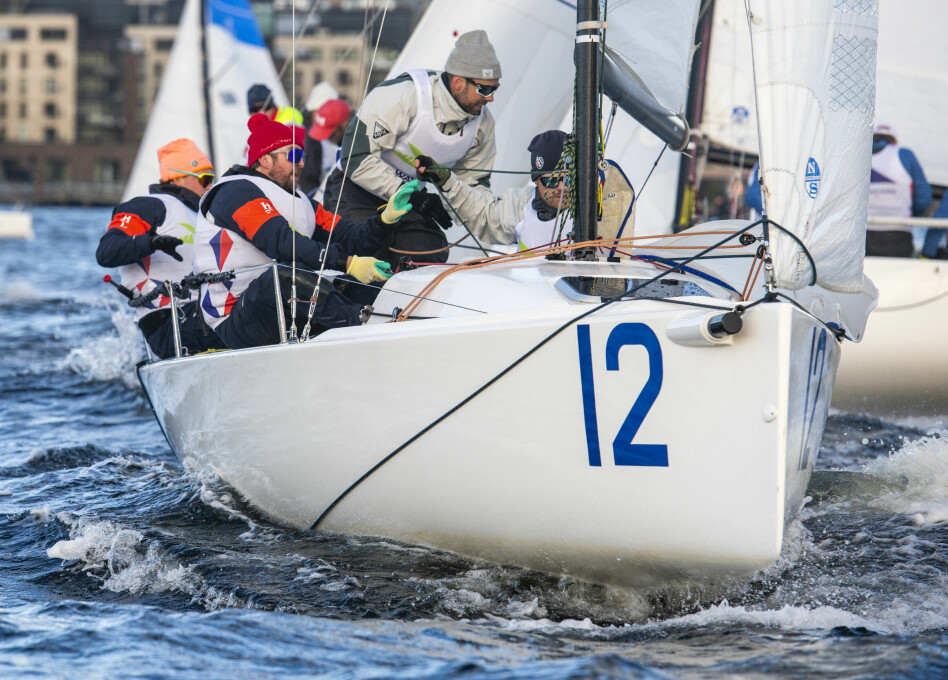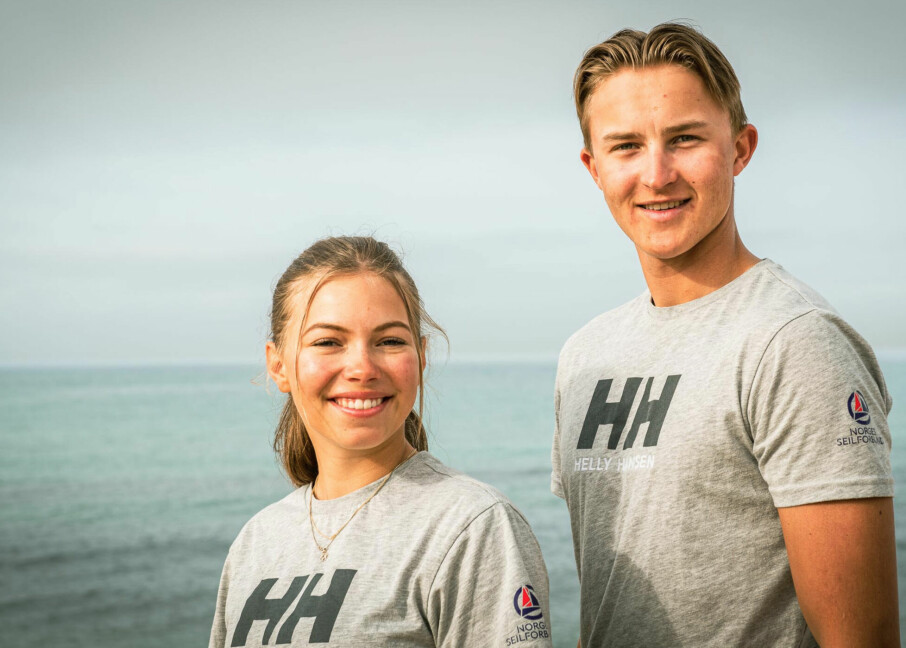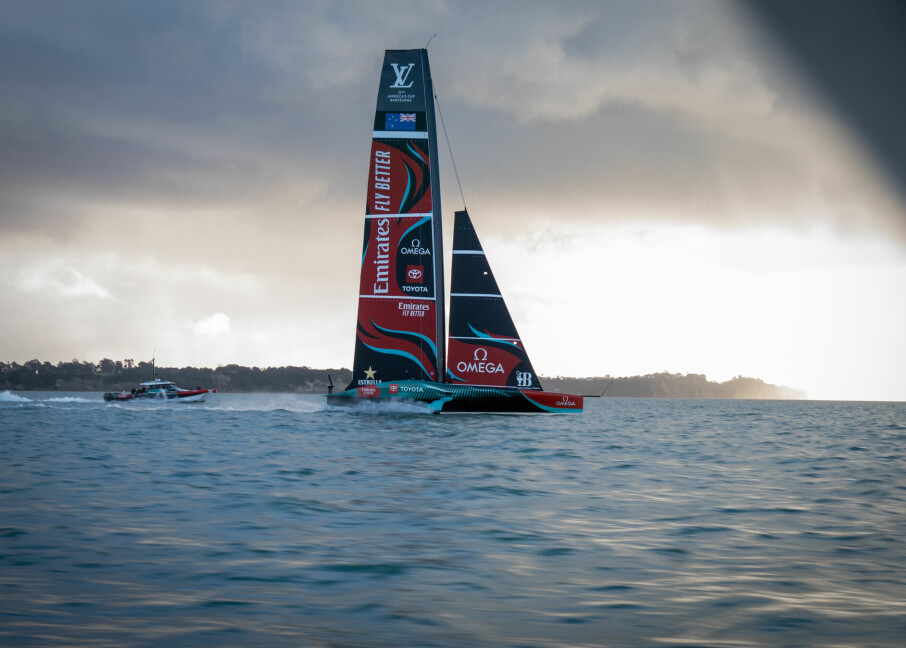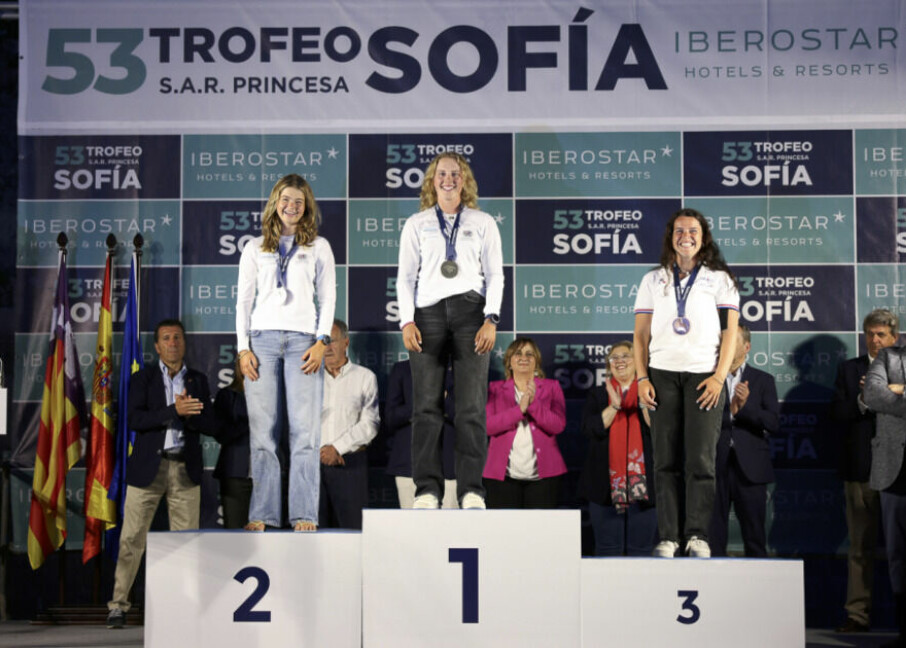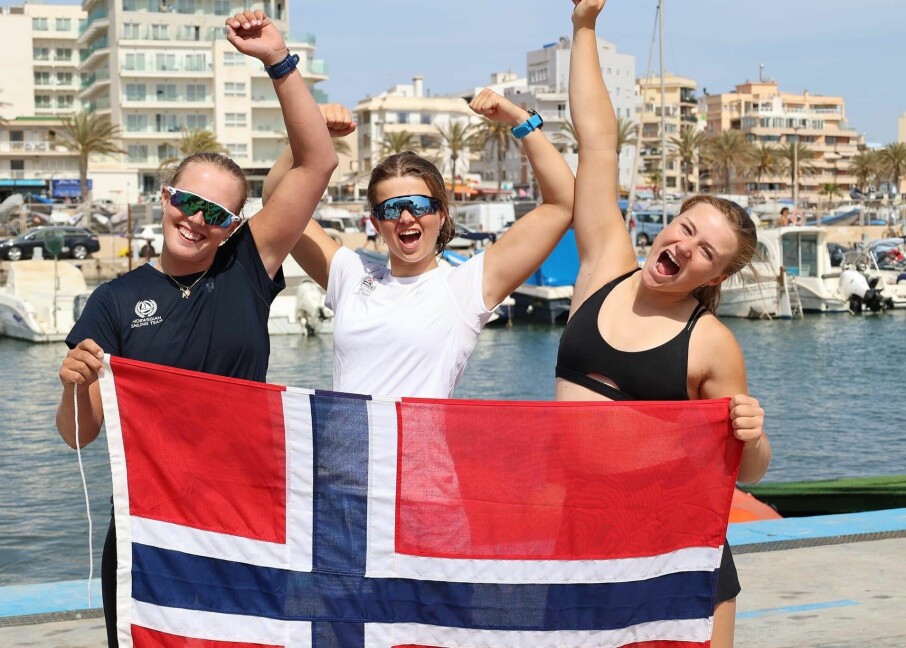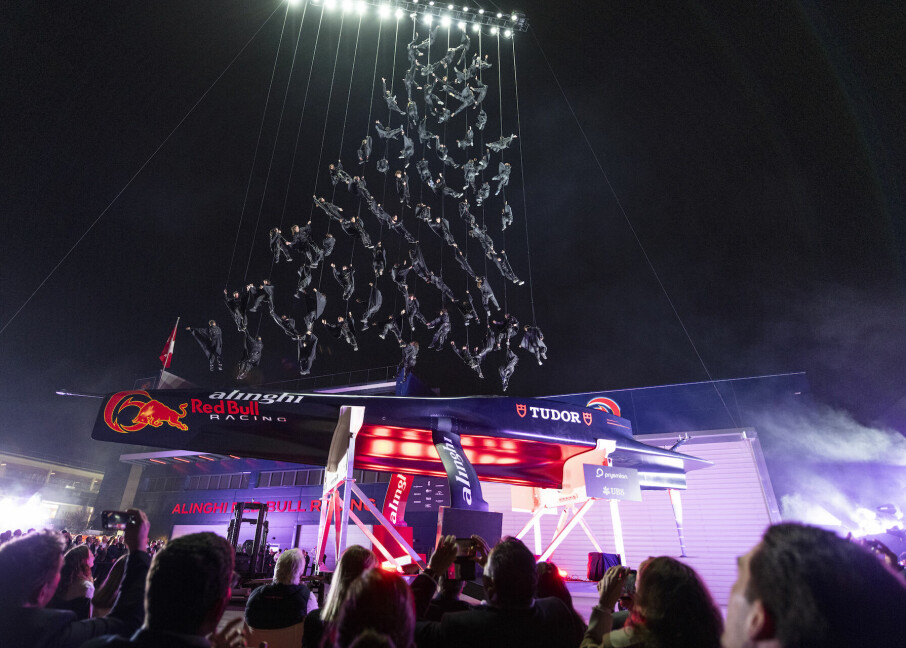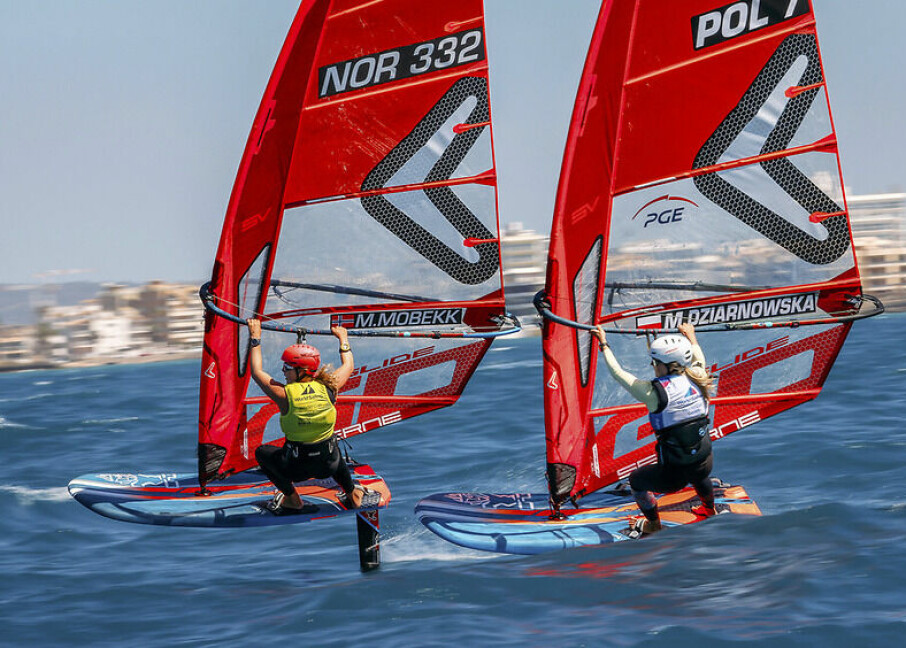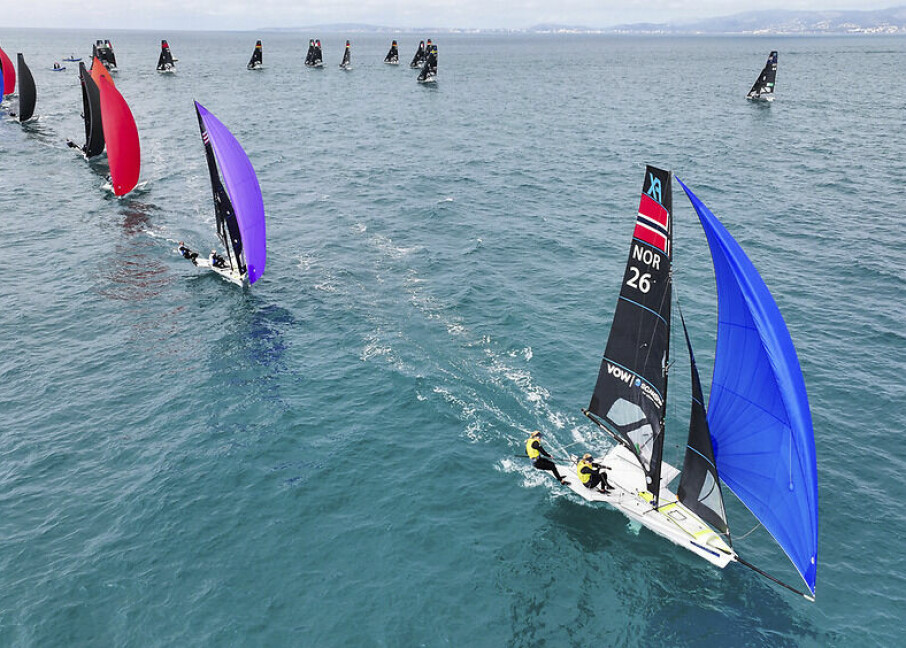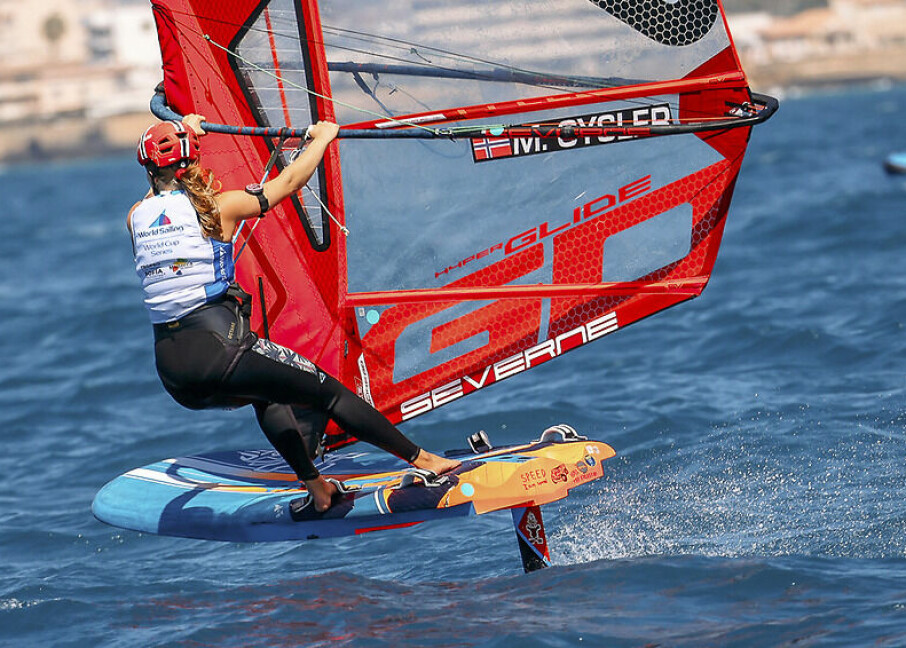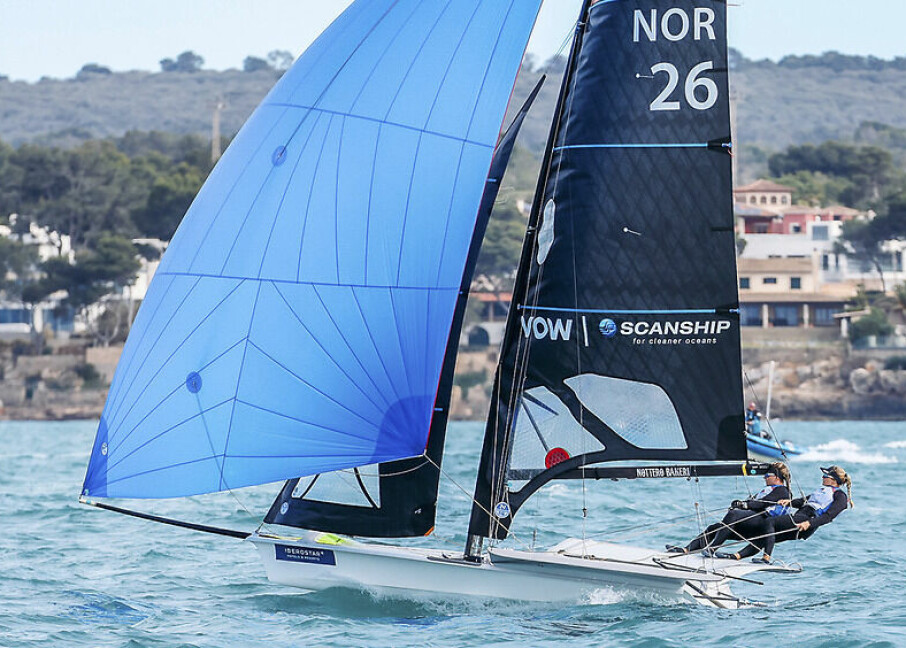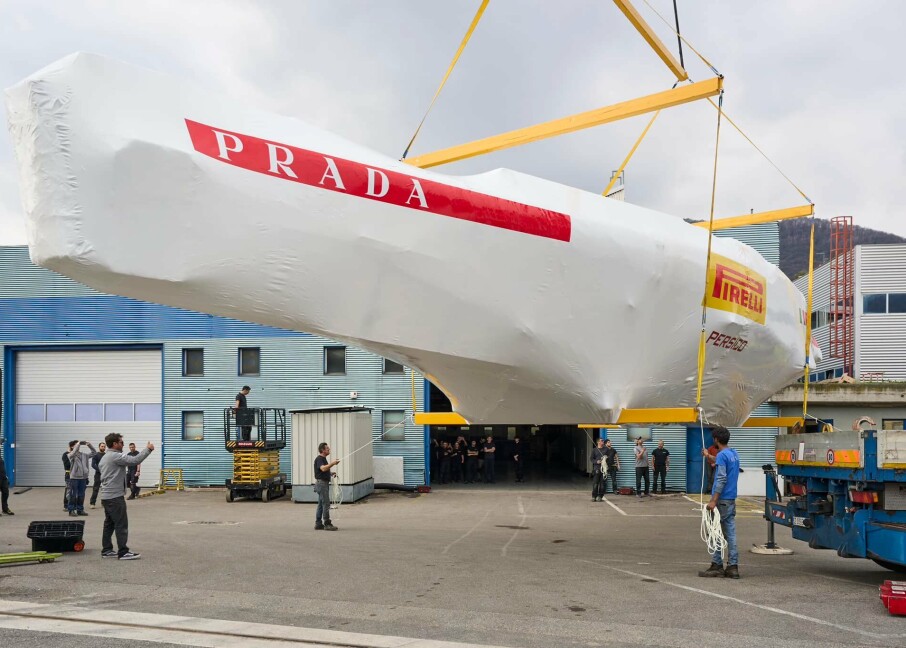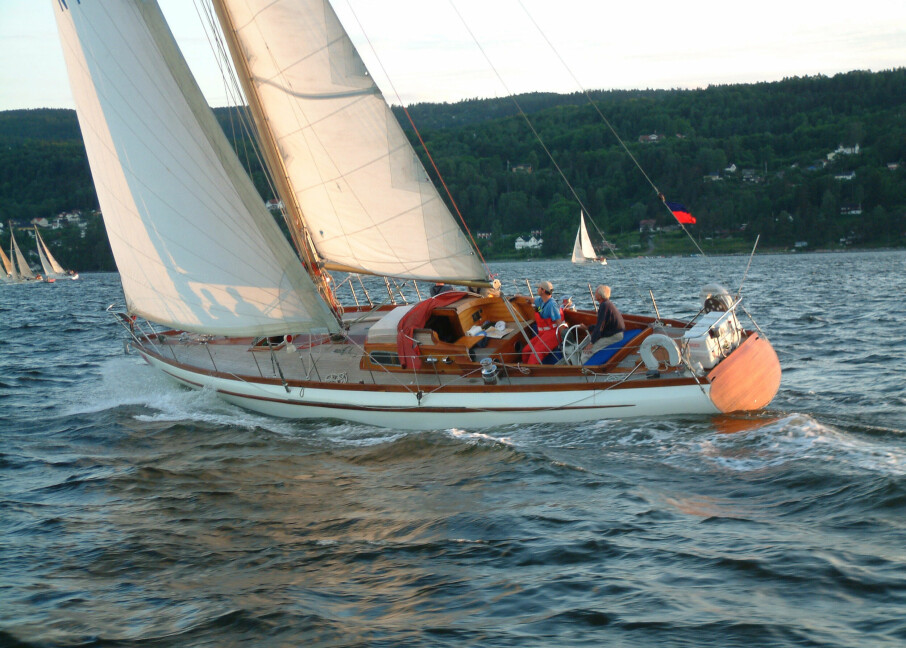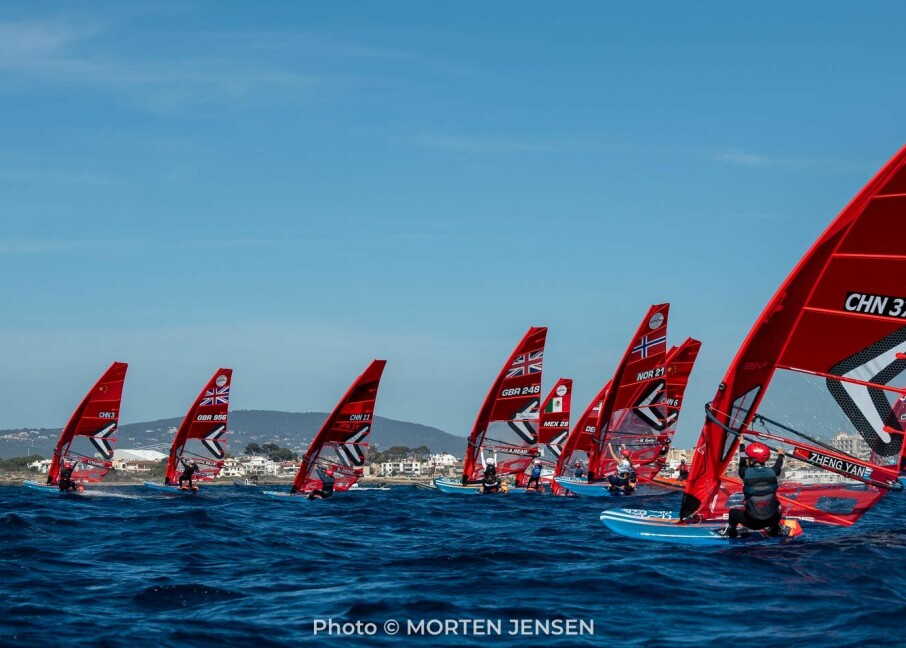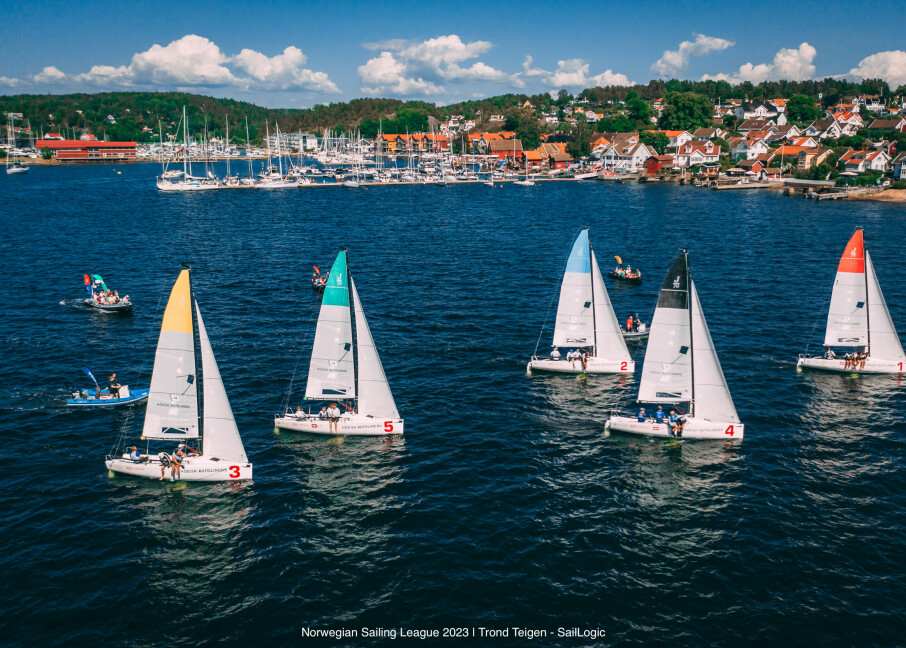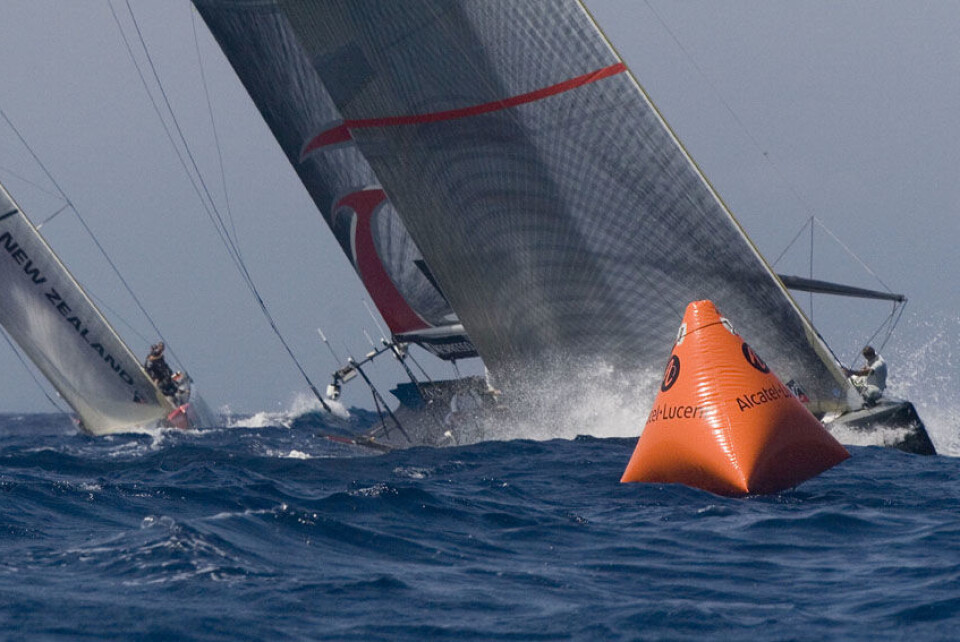
Trenger kun en seier
Etter dagens seilas trenger Alinghi bare en seier som å sikre seg America´s Cup, men igjen var det en feilmanøver hos New Zealanederne som reddet dagen for Bertarellis gutter
Etter at ledelsen hadde skiftet frem og tilbake på den første kryssen var det TNZ som tok ledelsen ved det første merket. 14 sekunder var de foran konkurrentene, og etter lensen hadde Alinghi tatt tre sekunder. Meget jevnt med andre ord, og helt åpent fremdeles. Et dårlig slag hos TNZ var alt som skulle til for at Alinghi skulle ta ledelsenpå den andre kryssen og ved kryssmerket hadde Alinghi 16 sekunders å gå på. I mål var marginen 28 sekunder i Alinghis favør.
Nå kan America´s Cup bli avgjort i morgen om Alinghi skulle vinne igjen, men det vil ikke være noen overraskelse om TNZ reduserer. Nå står imidlertid Grant Dalton med ryggen mot veggen og TNZ må vinne tre på rad om America´s Cup igjen skal havne i Auckland.
Følg med imorgen. Les mange kommentarer her:
SCUTTLEBUTT 2378 - July 1, 2007 (www.sailingscuttlebutt.com) Scuttlebutt is a digest of major sailing news, commentary, opinions, features and dock talk . . . with a North American focus. Scuttlebutt is distributed each weekday, with support provided by UBS, main partner of Alinghi, Defender of the 32nd America's Cup (http://www.ubs.com/sailing).
HANGING BY A THREAD
Team New Zealand's chances of winning the America's Cup now hang by a thread after Alinghi won race six in the regatta. The Swiss now lead the best-of-nine series 4-2 and will etch their name on the auld mug if they win tomorrow's match-point race. The final delta was 28 seconds. Alinghi came from behind for the second consecutive day to beat Emirates Team New Zealand on the waters off Valencia.
The Swiss Defender put in a strong, controlled performance on a difficult sea breeze day. Hundreds of spectator boats crowded the race course to witness the win. SUI 100 led early in this race, but halfway up the first beat, Emirates Team New Zealand was able to squeeze up to the Defender, and force Alinghi to tack. When the boats next converged, it was NZL 92 who had gained on the left to lead around the first mark. The Kiwis held on for the run, but on the second upwind leg it was Alinghi's turn to find the shift, making a gain on the right side of the race course. The Kiwis tried to fend them off with lee bow tacks, but couldn't make the third one stick, and Alinghi grabbed a lead it would never relinquish. The Swiss Defender has won the last three races of the Match to grab a 4-2 lead in the series.
One more win will see Alinghi hoist the America's Cup again, its first defense a success. For Emirates Team New Zealand, it's a difficult loss. The Kiwis now need to win three races without a loss to claim the America's Cup. --
COMMENTARY *
That could be it for Team New Zealand as they got sucker-punched into a tacking duel on the second beat from which they could never recover. Alinghi powered through having got the right-hand, starboard advantage after the leeward mark rounding and used their superior upwind speed to seize a lead that they would never relinquish. Today was the day for Team New Zealand to show the world if they had what it took to win the Cup but they just couldn't match the raw boatspeed and tactical nous of Alinghi who were far from on fire. I think that's it for TNZ now. There's no room for error any more as Alinghi advance to match-point and I just can't see the Kiwis turning this around in the small window they have left. So close but so far...it's the perennial story of the challengers. -- Magnus Wheatley, http://www.rule69blog.com/ *
Having been bullied around the start box on all but one of the previous pre-starts, Ed Baird came off the line at pace and on the controlling side as the start gun fired. But gaining the upper hand hadn't been easy. -- Matthew Sheahan, Yachting World,
BIG PAYBACK Forget Barcelona, Bilbao or Seville. Now it is Valencia's turn to bask in the international limelight. Spain's third-largest city has become a must-visit destination since Alinghi -- the sailing team from landlocked Switzerland -- won the America's Cup and Valencia was chosen to host the 32nd America's Cup. Valencia has taken a big leap forward. It is now a more open and cosmopolitan city than it was before and the people -- locals and visitors -- are embracing it.'' Tourists have responded, just as they did with Barcelona following the 1992 Olympic Games and Bilbao after the opening of the Frank Gehry-designed Guggenheim Museum in 1997. The latest statistics show Valencia experienced the biggest jump in tourism of any European city. The 1.6 million visitors who came here in 2006 were nearly five times the number who came in 1992. Better travel connections, including the rise of low-cost airlines, the advent of the Internet, a mushrooming of hotels, conference halls, and museum and art galleries are why Valencia's tourism numbers are expected to dwarf the 2 million visitor mark in 2007. Paul Logothetis, AP, full story: http://www.miamiherald.com/986/story/138638.html
TIGHT SECURITY Visitors numbering 70,000 some days and the moored rows of sleek superyachts owned by the superrich could make sailing's highest-profile regatta, the America's Cup, a plumb target for terrorists. More than 2,000 people, including scuba divers groping along the dark and muddy bottom and experts using sonar, infrared sensors, radio jammers and cameras, are determined to prevent just that. We have been working for three years for the worst case scenarios, so we think we are prepared," Jose Vincente Herrara Arrando said. At the entry gate, visitors wait in line to send their bags through a scanner, and then pass through a metal detector themselves, like at an airport. Cars are also stopped, and then drive over special detectors designed to find any explosives hidden under the vehicle. Apart from the fences surrounding the vast base and scores of police cars and officers, most security is barely noticeable, such as the 244 surveillance cameras keeping a Big Brother-like eye on things. Most, about 200, are along perimeter fences, which also have infrared and microwave sensors to detect efforts to climb over, something Herrara Arrando said has happened only once. The heart of the security is an upper floor of an old stone building in the port, where about 30 people, representing the police, fire, the civil guard, the military and organizers, are gathered to coordinate efforts. In an adjacent room, 18 widescreen monitors cover a wall, switching between remote cameras and other data. If an alarm is triggered at the fence, a remote camera kicks in to show what happened and prevent false alarms. The security services also use "intelligent video," which reacts to any change — such as an abandoned bag — in a defined image area. Another screen shows the license plate number of every vehicle entering the park, compares it to a database, and sounds an alert if, for example, the car is stolen. Yet one more screen has images from sonar — underwater radar — placed under the waterway leading into the port. Herrara Arrando said sonar could help detect, for example, a miniature submarine or unauthorized diver. -- Associated Press, full story: http://tinyurl.com/2gnflt
PROFESSIONAL SAILING (Following are excerpts from a story posted on the Business Day website.) Long the preserve of amateurs reimbursed by billionaire yacht owners, the America’s Cup, which went professional in the 1980s, today boasts a large number of sailors who have become highly paid stars in their own right. That sentiment has been embraced by modern-day yachting teams, which invest millions of dollars into assembling the best crews, offshore teams and boats, and spend the larger part of the year in full-time work. The most renowned sailors nowadays include Kiwi duo Russell Coutts and Brad Butterworth, both three-time winners, and American Paul Cayard, a finalist in 1992. Their services are keenly sought-after and their salaries strictly confidential. Coutts, who won the 2000 edition of the Cup with Team New Zealand, was poached by Swiss billionaire Ernesto Bertarelli for a massive € 4,8m (nearly 5.5 million US dollars) over three years. Five others followed Coutts, including Butterworth. While salaries may trail those of top footballers and tennis stars, they are a giant leap from life in yachting circles just 20 years ago. For the current campaign, Chris Dickson, helmsman and MD of the BMW Oracle team — losers in the semifinal of the Louis Vuitton — earns almost $2m a year, making him one of the richest sportsmen in New Zealand. French tactician Bertrand Pace, left ashore after a clash of personalities with Dickson, pockets more than € 35,000 a month (more than US$ 47,000), says a source close to the team. -- Full story: http://tinyurl.com/2ysdbj MUSICAL CHAIRS Russell Coutts, the New Zealand native regarded as one of the greatest America’s Cup skippers, is believed to be in talks to join the massive BMW/Oracle Racing team for the next campaign. After leaving Team New Zealand in 2000 to join Team Alinghi, the legendary skipper is seriously considering an offer to become CEO and skipper for the United States syndicate. The (New Zealand) Herald first reported the news on Sunday after learning that Coutts has been in discussion with BMW/Oracle owner Larry Ellison. No contract has been signed, but if terms are finalized an announcement could be made at the end of the current America’s Cup. The Herald reported that several key crew members who sailed with Coutts for both Team New Zealand and Alinghi – Brad Butterworth, Simon Daubney, Warwick Fleury, Murray Jones and Dean Phipps – would follow the Hall of Fame skipper to whatever team he chooses. -- Capital Online, full story: http://www.hometownannapolis.com/cgi-bin/read/2007/06_28-71/
SAL QUOTE / UNQUOTE Said Keith Mills, the British backer of his country’s America’s Cup campaign in the next event, and who led the successful bid to gain the 2012 Olympics for London, “The idea is to be in the top four in an America's Cup in 2009, win it in 2011, host the best Olympic Games in history in 2012 and defend the America's Cup in 2013, then die a happy man." -- http://sport.guardian.co.uk/breakingnews/feedstory/0,,-6734813,00.html
PROOF OF CONCEPT² America's Cup 33 will probably be just as exciting as this one. No more 5-0. It's been 24 years since we've had a contest for the Cup that had this sort of back-and-forth drama, and the new format—the pre-event racing—is responsible. As Alinghi tactician Brad Butterworth said after his come from behind win in Race 6, "The Acts brought all the boats together. If the defender has an advantage, they see it. They go into the LVC and the challengers get tough racing. And the unskirting shows everybody what you've got." Watching first-time challengers such as Shosholoza perform well against bigger teams gave me that thought a long while back, and I wrote a story called Proof of Concept. Seeing this kind of competition in the Cup racing itself convinces me that I am looking at Proof of Concept². -- Kimball Livingston, Sail magazine blog, http://sailmagazine.blogspot.com/2007/06/proof-of-concept.html
THANKS FOR THE MEMORIES No matter what happens in the remaining races in Valencia, Spain, two races have been memorable, and one -- Tuesday's -- the best since Sept. 26, 1983. From the perspective of the United States, that was the day of sailing infamy, when Australia came from behind in the final leg of the final race off Newport to wrest the Cup away after 132 years of American domination. On that light-air day on Rhode Island Sound, the Aussie winged-keel triumph over Liberty broke a 3-3 tie in which the US won at least a couple of races it should not have. Because more than 80 percent of Cup races end the same way the boats round the first mark -- putting a premium on the start and first crossing maneuvers on the beat -- what creates excitement in this game of match racing is lead changes. One lead change in a race is rare and stirring, two or more are miraculous at the top level of sailing. Most America's Cups have been shutouts, or nearly so. Five of the last six were sweeps, and the one that was not was the 4-1 victory of Bill Koch's America{+3} over Italy's Il Moro di Venezia in 1992 in San Diego. Many sailing fans have wistful memories of the 1987 Cup in Fremantle, when Dennis Conner sailed Stars & Stripes to a revenge victory over Australia. What they are really recalling, though, is that 30-knot afternoon wind called the Fremantle Doctor. It beat sailors and boats all over the Gage Roads course. What they may forget over the 20 years is that the US thumped Australia's Kookaburra five straight races. Only upstart New Zealand managed to take a race off Stars & Stripes in the challenger finals. -- Tony Chamberlain, Boston Globe, full story: http://tinyurl.com/yvrheg
AN OPPOSING POINT OF VIEW -- Simon Barrett Here we are over 20 years after the IACC was established and what have we achieved? Well very little, we have campaigns that are running in the many, many millions of dollars. We have a whole bunch of boats that sit in the same corner of the design box, in fact if you removed the paint job you would not be able to tell them apart. Yes these boats are fast, yes the crews are well trained and talented, but they sure have changed their racing tactics. Today’s America Cup race is just a great big yawn. Gone are the days of hunt and hide in the spectator fleet during the pre-start, instead they enter the box, go head to wind for 3 minutes, spin around a couple of times, and hit the line at full speed, if a little late. The current Americas Cup which matches Team New Zealand versus Alinghi, is the epitome of boredom. The boats are high tech, but they only like to go in straight lines. In the trade we call it ‘drag racing’. From the start line they drag race out to the lay line, tack once and drag to the windward mark. Yawn Yawn. Maybe it is the equipment, or maybe it is the crew, but it sure makes for boring racing. My personal theory is that the equipment is at the very edge of usability. And a tacking duel would likely result in a major equipment failure. All in all I think I prefer the ‘off road’ capabilities of the old 12 meter class to the Space Shuttle class of today. Oh, and not that anyone could care, the score is now 4 – 2 in favor of Alinghi. -- Full commentary: http://www.bloggernews.net/18249
SAILING SHORTS * BYM News has spoken to all but one of the America’s Cup syndicates that were knocked out in the Louis Vuitton Cup Round Robins. All but two of those syndicates has said that, if the Cup were to go to New Zealand it would make it extremely difficult for them to obtain sufficient sponsorship. The only exception is China Team, whose present major sponsors are entirely focused on the home market and would be happy to see the Cup in New Zealand, especially since the time difference would suit Chinese TV peak viewing schedules. -- http://www.bymnews.com/news/newsDetails.php?id=11230 *
Due to Ben Ainslie’s ongoing commitments with Emirates Team New Zealand at the America’s Cup in Valencia, he will be unable to compete at the forthcoming ISAF World Sailing Championships in Cascais, Portugal. As soon as the winner of the America’s Cup is decided, Ainslie will head straight back to the UK and start training in his Olympic Finn dinghy, the class he won his second Olympic gold medal in at the Athens Games in 2004.
